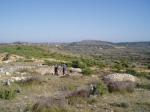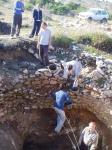Summary (English)
In 2005 the excavation of the architectural remains at the Pećani site continued. The research lasted 36 working days (from November 2 to December 23 2005). The site is located on cadastral parcel no. 1377/2 in cadastral municipality of Piramatovci. The site has so far been almost unknown in the archaeological literature. The toponym itself is known for Paleolithic artefacts which are kept in the Šibenik City Museum and from the literature on the medieval history of the region. The village of Pećani is mentioned in historical sources from 1442 and 1447 as the estate of the Ugrinić family, a branch of the Šubić family. The first archaeological excavations were carried out in 1986 when colleague Gunjača excavated two medieval tombs. On that occasion bronze pins – hairpins were found. The excavation on this position in the year 2000 was prompted by the fact that the locals started using gravel to build houses and thus endangered the site. The destruction was prevented, and excavation continues to this day. In the 2005 campaign, research into architectural remains continued. In the previous year, the trench was extended to 6 m and has an average depth of 3.4 m. Due to the poor preservation of parts of this building and to prevent the unearthed wall from collapsing before the next year, the excavation was conducted only on its inner side. Upon completion of the excavation, it can be almost certainly identified as construction that served for the accumulation of drinking water, and it is even possible that at a certain time it was enclosed. It is important to note that the cistern was probably repaired as in the lower part the construction of the wall is better and also smoothed with some kind of hydraulic mortar. Its bottom part was dug into the bedrock, and the traces of burning were found, leading to the assumption that it may have been covered with a wooden structure that burned down. Four test trenches were opened near the building, in places where potsherds were found and which were slightly elevated relative to the surrounding terrain as an indication of buried remains of architecture. Unfortunately, the trenches did not give the expected results. With the excavation conducted in 2005 the works on the building were completed, and in cooperation with and on the instructions of conservators from the Conservation Department in Šibenik conservation and structural repairs are to be conducted (Ž. Krnčević 2006, Hrvatski arheološki godišnjak 2/2005, 338–339).
- Željko Krnčević
Director
- Željko Krnčević
Team
- Rade Žunić
- Toni Brajković
- Marija Krnčević
- Milena Čupin
Research Body
- Muzej grada Šibenika
Funding Body
- Ministarstvo kulture Republike Hrvatske
- Šibensko-kninska županija






![Download [PDF]](/excavation/skins/fasti/images/results/download_sml.png)
